Table of contents
- New Honda V4 Japanese apply for first patents
- Cylinder deactivation known
- V4 with variable number of cylinders
- V2 below, V4 above
- Conclusion
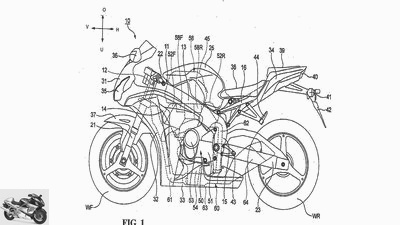
Honda engine
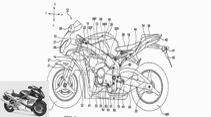
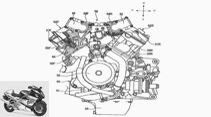
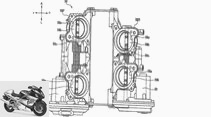
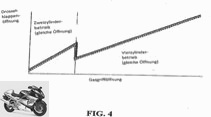
5 pictures
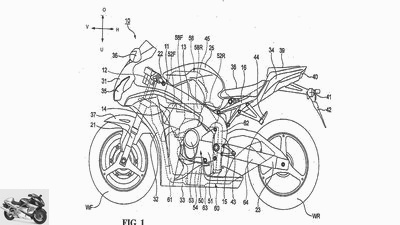
Honda engine
1/5
In 2021, a rather old patent application from Honda suddenly appeared in Germany as well. Honda patented the invention of a new V4 with a variable number of cylinders.
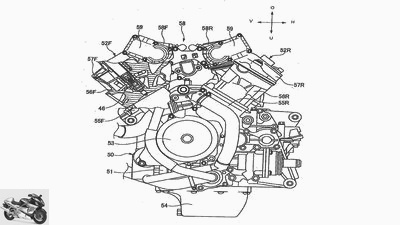
Honda engine
2/5
The V4 appears to have a cylinder angle of 90 degrees. The high structure of the intake tract is noticeable.
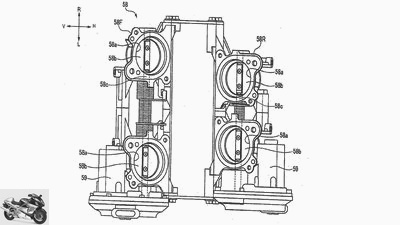
Honda engine
3/5
Viewed from above, the inside and outside cylinders of the cylinder banks are also noticeable.
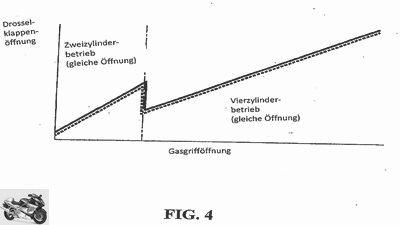
Honda engine
4/5
Part of the riddle: Honda wants the engine to run as a two- or four-cylinder, depending on the throttle position. The front cylinder bank can be switched off.
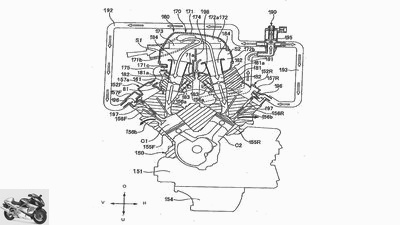
Honda engine
5/5
The high structure of the intake tract is explained by the planned system of guiding the blow-by gases from the cylinders that are moving into the ignited ones so as not to interfere with the exhaust gas purification.
counselor
technology & future
Honda: patent for new V4
New Honda V4
Japanese apply for first patents
The rumor that Honda is building a new V4 engine has haunted the world for a long time. Now the Japanese have registered patents for a possible new four-cylinder in V-shape in other markets.
Jens Kratschmar
06/04/2021
In this article:
- Cylinder deactivation known
- V4 with variable number of cylinders
- V2 below, V4 above
- Conclusion
In fact, the patent for Honda’s V4 with load-dependent cylinder deactivation is not new. Honda had the special construction protected in Japan and the USA as early as 2013. Only recently this very special motor received patent protection in Germany and the EU. Old hat? Perhaps. Still interesting? Definitely.
Cylinder deactivation known
The subject of cylinder deactivation is well known in cars, with low loads in the city or in stop-and-go operation, especially in large engines with many cylinders, several simply switch off. That saves fuel. Work at motorcycle Harley-Davidson, Indian or Ducati with this gimmick to the temperature of the rear cylinder or at Multistrada V4 To keep the rear cylinder bank under control: Standing at the traffic lights, the Harley is somewhat reminiscent of a jarring single-cylinder. Problem: Despite the injection and ignition being switched off, oxygen is pumped into the exhaust tract, which can affect the exhaust gas cleaning process in the long term. That is also one reason why these systems no longer work at higher speeds. This is where Honda comes in with the V4 patent. The Japanese want the engine to run permanently as a twin when the load is low and only switch to four-cylinder operation when the load is high.
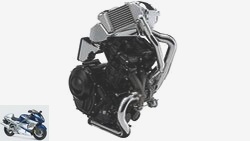
technology & future
Suzuki patent for 650 cc parallel twin
Turbo-Twin for the SV 650 and V-Strom 650?
read more
V4 with variable number of cylinders
Viewed from the side, the engine appears to be a V4 with a cylinder angle of 90 degrees. What is striking, however, is the rather high structure of the intake tract. This has several special features. On the one hand: the front cylinders are significantly further apart than the two rear cylinders. Second: The blow-by valves of the engine ventilation do not simply lead back into the airbox, but have flap and valve control that connects the two cylinder banks. Honda would like to enable cylinder deactivation even under load conditions above idling and higher engine speeds, without the unburned air from the pumping cylinders affecting the exhaust gas cleaning process and generating harmful exhaust gas components such as nitrogen monoxide. So Honda directs the so-called blow-by gases from the rotating cylinders to the igniting ones. Due to the combustion of the oxygen, the ammonia that is sometimes formed cannot be catalyzed back to nitrogen oxide with the unburned oxygen.
V2 below, V4 above
Honda is probably planning to run the engine as a twin in the lower speed range and as a four-cylinder in the upper speed range, depending on the required power and throttle valve position. This is somewhat reminiscent of the V-Tec engines of the VFR 800 V-Tec or F. The exact meaning of the patent is not revealed, as is the unusual arrangement with internal and external cylinders, but that is exactly what makes it interesting.
Conclusion
What to make of it? The patent has been roaming the world in all languages since 2013. In 2021, where V4 engines are only built in absolutely insensitive budget areas, a German version of the patent will suddenly appear. Instead of Supersport, Honda thinks of variable number of cylinders, fuel savings and clean exhaust gas with this V4. As interesting as that sounds, it also seems absurd when you consider the horrendous costs of a V-engine.
Related articles
-
Suzuki patent Radically changed engine mounting position
Suzuki motorcycles Suzuki patent Radically changed engine mounting position Suzuki patent Radically changed engine mounting position A motorcycle engine…
-
Honda NT 1100: Crossover bike with Africa Twin engine
Honda 18th pictures Honda 1/18 Honda has patented new frame concepts for the two-cylinder Africa Twin. Honda 2/18 The patent lists two framework…
-
motorcycles Honda: model history Honda: model history The world masters Honda’s dominant market position is not just the result of a chain of successes….
-
motorcycles Enduro Technology Honda CRF 450 R Technology Honda CRF 450 R For the sake of simplicity Why complicated when it can be made easy? This is…
-
Honda patent new variable valve timing
Honda 12th pictures Honda 1/12 Honda has patented a new variable valve control. Honda 2/12 The new variable valve control in the engine of the upcoming…
-
Honda patent: drone as a dinghy
Honda 5 pictures Honda 1/5 Honda has patented a system in the USA in which an electric motorcycle works together with a drone. Honda 2/5 The drone itself…
-
Honda compressor patent: series twin with supercharging
Honda 5 pictures Honda 1/5 Honda has combined the Africa Twin’s in-line twin with a supercharger in a patent specification. Honda 2/5 The twin screw…
-
Honda CBF 600 S, Suzuki Bandit 650 S, Kawasaki ER-6f, Suzuki SV 650 S
Artist 18th pictures Honda 1/18 Honda 2/18 Honda 3/18 Honda 4/18 Honda 5/18 Honda 6/18 Honda 7/18 Honda 8/18 Honda 9/18 Honda 10/18 Honda 11/18 Honda…
-
Endurance test final balance: Honda Fireblade
Bilski motorcycles Endurance test final balance: Honda Fireblade Endurance test final balance of the Honda Fireblade Conclusion after 50,000 test…
-
Second hand advice Honda CB 750 K-F
counselor Used purchase Second-hand advice Honda CB 750 K / F Second-hand advice Honda CB 750 K / F Awake The second generation of the Honda CB 750…